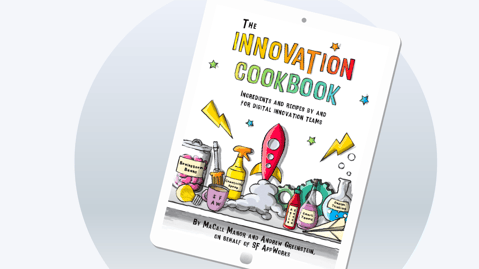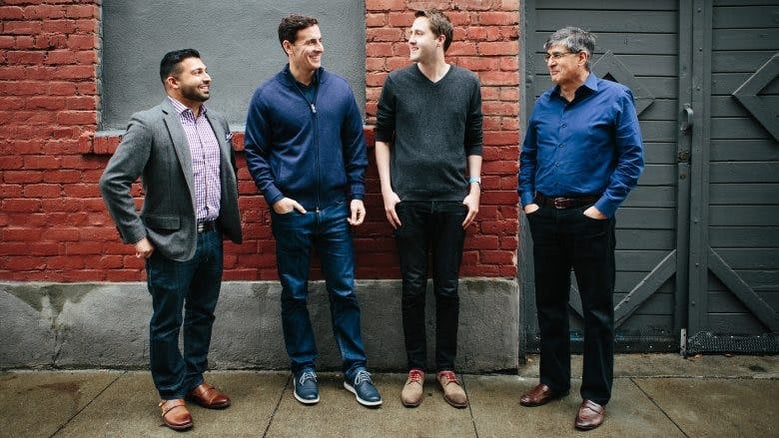This article is a continuation of Recipe: Startup Innovation with Erick Hachenburg, Part I: a conversation we had this season on our podcast, the Innovation Cookbook. In Part II, we'll explore the launch of (and thinking behind) Erick's company Tenor, but if you're interested in learning more about the early part of his career, be sure to read Part I.
Ingredient: Facing the Right Way
As we transitioned into what is arguably Erick’s greatest success in Silicon Valley, we tried to dig deeper into his innovation philosophy, asking him first if he had a favorite book or methodology. He noted that The Innovator’s Dilemma was a favorite title of his, calling it “one of the fundamental reasons that it’s hard to innovate at a big company. It’s one of my favorite books—business books.”
We asked him why.
“My takeaway—the takeaway, for anyone, that is—there is this concept that it isn’t that companies are poorly managed...it’s more that they’re well managed that they miss the innovation, that they miss the change in the marketplace. Because if you are well managed, and you look at your existing business, your existing feedback loops, or your profitability, and you use those to manage your business. So if there’s a dark cloud around the corner, or an opportunity—a bright light around the corner, the metrics for that haven’t been devised yet.”
Erick agrees that when a company is fine-tuned and organized, a lot of its decisions are made based on careful measurement of the past—a practice that counteracts creative visualization of what’s to come. Whereas the entrepreneur might believe in a future possibility (even one that goes against the grain), and that might lead him to take greater risk or detect a change in the marketplace that a more calculated, safe, and premeditated leadership effort might miss.
A collective desire to understand what drives innovation and the subsequent deep-dive research has resulted in a body of work concluding that less pressure, and more room for unconventional, un-deadline-restricted free thinking are the answer. Some theorizers recognize that a walled-off innovation team might create that freedom within an organization. We asked Erick about his thoughts on that approach. He agreed that it was certainly a viable option. In assessing innovation in small vs large companies, he pointed out something that’s often overlooked. That is: when we read or hear about startups, we’re usually looking at the ones that have succeeded rather than the ones that have failed. Meaning, the large successes in Silicon Valley are much more rare than we realize.
“The problem for most large companies...it isn’t about whether [or not] they can be innovative. It’s about whether they’re the one that succeeds. When you’re looking at startup companies—especially if you’re in the business of acquiring startup companies, you wait to see who’s going to succeed. If you thought that you could invest in the right one every time, you would do that. But you can’t, so you wait to see who is successful.”
From his perspective, it’s not that startups are shockingly more innovative than large companies, it’s more so that they have the freedom to fail a lot—unless they’ve failed so hard or so early that we’ve never even heard of them. To the point of walled-off innovation efforts:
“Large companies, if they wall people off and say: ‘go succeed,’ well, that’s as hard as being in the VC business, in a sense. You’re like, [‘you’ve] got to pick the winners?!’ So what’s your playbook for that?”
Andrew pointed out that a lot of the biggest companies innovate through acquisition. Which is true, Erick noted, but there is something special about innovating as a startup, in trying to build something from the ground up.
“It may be inspired by things that are in the marketplace, but there’s got to be something that you think is different enough to make it worthwhile to chase it. That innovation is really hard and really risky…”
There’s a distinction between being innovative with originality and being innovative with respect to an existing product (something a lot of big companies do decently well):
“They’re using innovation not to create entirely new market places, but to continue to evolve the consumer experience in ways that delight their customers...So I think you can still innovate, but that’s not a walled-off experience... that is innovation within your core product. And that’s a whole different type of innovation than startup innovation.”
Google’s magnitude has allowed it *eye roll* to pay certain employees a salary to build startups within the company. Beyond that, they also have the bandwidth to operate several funding arms that are continuously investing in external startups. Erick mentioned Google’s “Street View” feature, part of Google Maps, as a particularly impressive innovation:
“That wasn’t exactly a startup-like experience, you had to be a big company to do it, but I think it was innovative. Not just innovative in introducing the feature, but innovative in doing it. ‘How did you build a camera that you could mount on a car and drive down the streets and capture everything? That’s innovation, right, but it was definitely leveraging an existing product that had success.”
Get a Free Copy of "The Innovation Cookbook"

Baking Tenor: Key Ingredients

GIF keyboard platform Tenor marked the first time Erick built something from the ground all the way up. Tenor exploded onto the tech scene; one day it wasn’t there, and the next day it had a beating heart of tens of thousands of users.
We wanted to know what happened.
Interestingly enough, Tenor was the result of an early investment in the right people rather than a specific vision or idea. Erick and his cofounder, David McIntosh, would meet periodically to discuss things they were interested in doing together.
“I just remember saying to David: ‘mobile video. There has got to be something in or around mobile video, because it doesn’t feel yet like it’s big enough yet—there’s got to be something there.'”
Vine was there, but it was acquired strangely early in its life-cycle by Twitter (before sort of dissolving). Youtube was, of course, a worthy competitor of the idea, but it was more of a desktop/web presence. It wasn’t built specifically for mobile play—a crucial distinction I personally never realized makes all the difference.
“And [Youtube] did port [its technology], but porting, the assumption that we always made, is that porting from one platform to another is not innovation. I have this sort of operating theory that every new platform should spur some new form of innovation for each medium...you have to reinvent the media business, the entertainment businesses, the content businesses, for those particular use cases that are going to be different. And the idea of porting Youtube is important, and people do it (I watch Youtube videos on my phone all the time), but it’s not innovation. And it’s not going to define that medium, necessarily. There’s always something new and different there.”
Andrew made the connection to TikTok, which has certainly blown up to epic proportions today in 2020––a mobile video platform that was really “designed for the hand,” as he put it.
Says Erick, “Yes. [At the time] I believed that mobile video had not achieved its greatness yet...there doesn’t have to only be one solution...TikTok; Snap is another one that did amazing things with mobile video. Instagram reinvented the photo space. They made it for phones. There were plenty of photo sites...shouldn’t they have just ported to Instagram? No. Because you had to invent it for the mobile phone, which meant you had a camera now for the first time, attached to the platform. That made everything different—and if you could enhance the photo in a way that made it look great and proudly display it, that changed the photo industry.”
It all boiled down to some key observations of a market that Erick and David were fortunate enough (smart enough, rather) to gain access to.
“We knew it had to be shorter. We knew video was important. We knew short was important. We knew mobile was important. And, we basically set out to build a company to be something important in the mobile video space.”
We asked how the launch went—specifically how they were able to get such massive traffic so quickly. The answer lay in the story’s much earlier exposition.
The partners had built an original app that ultimately functioned as a playground for them to learn more about mobile video—a simple creator where any kind of visual content was fair game (think video, still images, powerpoint slides, etc.) The content could be mixed as desired, packaged, and shared. The return was an understanding of what types of content people wanted to use, and the implied use-cases. The app was called Riffsy.
Says Erick, “[Riffsy] allowed us to rapidly experiment—we could introduce new features, we could test new ideas, so we would constantly be innovating there.”
Andrew asked where these users were coming from. Turns out that Erick’s co-founder was a decent growth-hacker (I didn’t even know was a thing).
“He knows how to spend a little bit of money, but also using growth hacking techniques, meaning: how do you get more people to share more, how do you get people to click back, how do you get viral support for it? So, it wasn’t a runaway success, but we had a community of tens of thousands of users, which is not a success by any means of a business, but it’s very successful in terms of having a user base to test ideas with—having real users, at that scale.”
Another turning point was when David urged the team to implement every single possible sharing platform on Riffsy—including messengers like WhatsApp...a choice that might seem sensical now, but at the time most people barely knew what WhatsApp was.
Related: 11 BEST ENTREPRENEUR PODCASTS FOR 2023 - LESSONS FROM STARTUP LEADERS
“...[the idea was] put it in messengers, because people might want to share in messengers. So what really happened was, we saw traction with that. We saw traction in that people were using GIFs a lot (they’ve been around forever), and we saw traction in that people were sharing into messengers. And the insight came that: “oh, they were using it to express themselves. So then the idea is, hey, emoji are used to express yourself, and on iOS emoji are shared by way of a keyboard––the emoji keyboard...you hit the globe on your iPhone and you get another keyboard...so we thought hey, we should make a GIF keyboard––a keyboard that allows you to find the right GIF at the right time to express yourself in the same way that emoji did, but with unlimited content.”
You might think the rest is history. But maybe there’s a lesson to be learned here in what comes immediately following a great idea: obstacles.
Ingredient: Adapt—quick.
At the time when they made this discovery, iOS didn’t support custom keyboards, so they started building on Android, but the path was lain with roadblocks.
Says Erick, “This is where the execution comes in, right—on Android it was hard to switch between keyboards, unlike switching to the emoji keyboard on iOS. Even worse, it was not consistent how the GIF would be shared...sometimes it wouldn’t be shared at all, sometimes it would share a link, and you had to click on it—how uninspiring is that? Sometimes you would actually get the GIF, sometimes you would only get the first image frame of the GIF, but it was just so inconsistent.”
That being said, they were continuously renewed with hope and motivation about the product; in test groups, people loved the keyboard when it did work correctly.
Erick and his team were in the technical trenches when suddenly Apple announced that iOS would support custom keyboards for the first time. I wish I would have asked how that phone call went between Erick’s colleagues—was it cheers-ing with beers, or The Fast and the Furious: Rush to the Office? Either way, the timing was beautiful—by this point they had tested their sandbox, seen promising traction, and were given the exact opportunity they were waiting for.
Erick recalls, “It was June, and September was the launch. So you have literally three months to build a product from scratch. So we were off and running. We were building the GIF keyboard for iOS, and that’s what we did.”
Ingredient: Preparedness
Timing and preparedness had a lot to do with the success of Tenor’s launch. Thoughtful market research, testing with consumers, and understanding what testers liked and disliked about an early version of the product were all crucial to its coveted reception. But the tech world (really any competitive product climate) can be ruthless. Right after the GIF keyboard came out, several other clones were already there to compete.
Says Erick, “I always make the comment, ‘we invented the GIF keyboard, and then 20 of them came out right after.’ We were the first and best to launch... you think first to market is so important. But you have to be good.”
What separated Tenor wasn’t only its first-place finish to market. It was well-vetted, well-tested, and had a strong architectural backbone to set itself apart from its competitors.
Ingredient: Relationships and Partnerships
Large companies and startups notoriously struggle with, well—each other’s strengths. Large companies have access to a lot of resources that smaller companies covet, but many have made the argument that startups are consistently innovative, while larger companies have a harder time designing innovation mechanisms that deliver. We tried to break this down a little more with Erick, who’s spent a lot of time working for both. He had some thoughts on what startups could take away from big companies.
“—you should try to figure out how you can at least be in conversation with the large companies, about your business, where possible. If you can get to know some of the potential partners or acquirers over time...I think that the biggest risk big companies think they’re taking when they’re buying a new company or a startup company is knowing whether it’s for real or not. The number one way you can prove out that you’re for real, and [alleviate] their concern is...if you’re saying what you’re doing and doing what you’re saying to them, over time, they become much more comfortable with the idea of potentially acquiring you, right. Like, “Hey! We’re going to go build this thing. Come back six months later: we built this thing! Look!” There’s some comfort that comes in that.”
It is a little different when you’re talking about acquiring an already successful company (Erick mentioned Google’s acquisition of Nest). In those cases, it’s usually pretty apparent that the individuals who make up the company are doing something right; they’ve already delivered on something innovative. But when you’re trying to prove yourself as a smaller company, it’s important to set the precedent that you do what you say you’re going to do. Probably a good piece of advice for life in general.
He also talked about the importance of building relationships early on.
“Big companies see so many things. They see so many small companies, they have tons of access to data because they have so many consumers, oftentimes, using their services—it’s worth your time to ask questions, you’ll learn. These are going to be useful meetings, too. But it’s not because you’re trying to sell the companies, it’s because you want to build the relationship. That advice is not about how to operate your business, that’s just: if you can get to know the big companies, you should do it.”
Andrew agreed that forming those partnerships early is beneficial because it shows that large companies are more accessible than you might think, and it gives you an option for a distribution partner, as well as the chance to prove yourself over the years.
What a startup can learn from a big company: just do it.
One insight that was particularly interesting to me:
Erick seemed to think that startups may foster a more private environment out of worry that larger companies will poach their ideas, but that might actually be somewhat of an irrational fear.
“I’m not necessarily a big believer that the idea itself is the whole value proposition. Meaning that, some people are worried that if you share an idea, that some other company is going to run with that idea, and you’ll lose out and they’ll win. I have very little fear of that with big companies.”
Per his experience working at powerhouse companies, Erick didn’t see large companies being able to take the idea and execute it more efficiently than a startup would. Of course there are times when a large company might have better access to investors, and putting oneself in the direct line of competition with a big company, as a startup, is probably unwise. On the other hand, if the idea is strong and can thrive on the flexibility of a startup, there are plenty of upsides to operating in that space; smaller companies can sometimes take greater risks (regulatory risks, etc) that might be imprudent for a larger company to take, and in general they move faster.
“I mostly think that’s true with other startups too, that your vision for your idea is very specific to who you and your team are, not what the next person who gets your idea is going to do with it. They’ll take it some other direction, most likely.”
Andrew pointed out that there are always a thousand ideas that take shape along the process—distilling a successful startup down to just one idea undermines a long string of inventive decision-making.
These ideas and decisions help you execute cleaner, react more, and better understand the opportunity.
Ingredient: Decision Making
Erick identified a noteworthy struggle at big companies: quick decision making—specifically, empowering decision making at all levels of the company.
“Oftentimes [decision making is] what’s hard for a big company to do quickly, because there are so many stakeholders, there are so many restrictions, there are so many people who have to approve, etc. So if you can figure out how to push decisions down, and make those real decisions, it will allow for a faster pace of development, and I think therefore innovation.”
The “next big idea” is certainly a part of innovation—building on top of, or finding novel uses for technology that already exists. A powerful feedback loop is a tool in that process as well; understanding how people are experiencing a niche set of circumstances can be a springboard for those processes to begin. Another equally important tool, Erick argues, is speed.
“The speed thing does really lead, in part, to more innovation if you do something with it. And that comes down to decision making. So the main thing I try to do is try to make decisions. Empower people to make decisions. I’m not a full believer in the old adage of like, ‘any decision is a good decision,’ or ‘it’s more important to make a decision than to make the right decision’—I understand the tension in that conversation, of like if you stew on the decision forever, than you’re not helping your company, but if you also make the fastest decision you can, and it’s clearly a bad decision, that’s not good either, right. You need the balance between the two. There are times when you’re like, ‘hey, that wouldn’t be my decision, but we need to keep moving.’ And you can own that decision and play it out.”
Andrew agreed, noting some of SF AppWorks’ experiences working with larger companies—one decision gets held up because multiple people in different parts of the organization have to weigh in or approve it before it can move forward.
The two agreed that something a big company could learn from a startup is: you’ve got to be able to make decisions—and as quickly as possible.
This is the Innovation Cookbook, so wrapping up, we asked Erick what his recipe would be for building and managing a startup team.
“I guess ‘recipe’ is a good analogy, because it is the mix of different ingredients that bring something to life that is great. I do think that’s true, that you need people with different experiences, with different skill-sets, different backgrounds. You want different perspectives, different insights, to make sure that you are being innovative. I know that creativity and innovation aren’t the same thing, but this idea of being open to ideas is an essential part of innovation, and along the way...how you implement also needs to be creative. How you expand needs to be creative. So bringing together different types of people in your team, I think is essential to success. The baking or cooking of it is around having a culture that is open, that is willing to question assumptions, that is willing to try new things—to answer the question you might not understand, because it may help you reveal what’s really underlying, what’s going on. You asked the question for a reason. If you keep asking the question, I guess it’s the five whys, you get to the core of what is the inside, or what is the point of the question..."
So if you can do that, if you can put the different ingredients together, the backgrounds, different types of people together, and you can foster a culture of openness and creativity, I think you have the makings of an innovation team.”
If Erick were going to create a new startup or team with five roles, he would choose the following:
- A great engineer
- A designer, or ‘someone on the design side’
- Someone in business development, although he noted this role really would depend on the company or product you were trying to build. A lot of online businesses are responsible for constantly interacting with and understanding their community, so having a role for that can be important.
- Someone in either sales or marketing, although he noted that plenty of businesses that don’t think about sales or marketing whatsoever and do just fine.
Thanks for reading and/or listening. Be sure to check back in the coming January—we have an exciting next few guests lined up.


COMMENTS